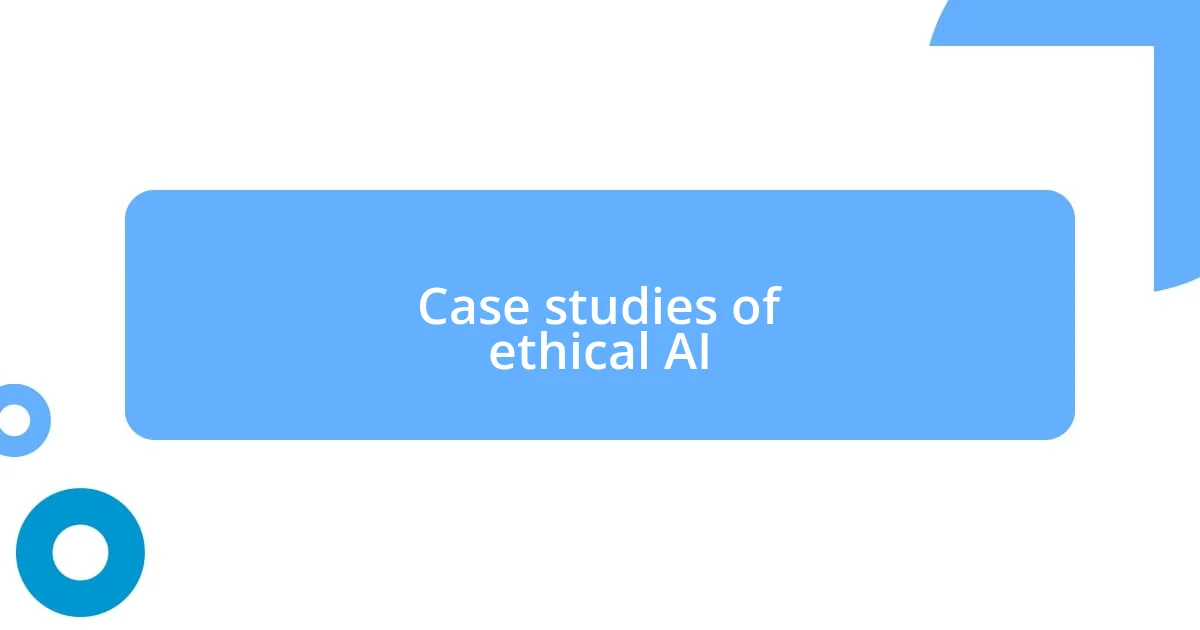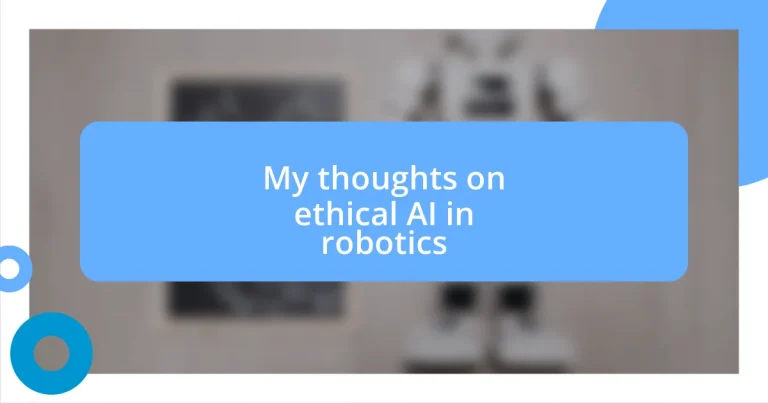Key takeaways:
- Emphasizes the importance of ethical AI principles: fairness, transparency, and accountability to ensure technology serves all individuals equitably.
- Integration of diverse perspectives in AI development fosters inclusivity, helping to create more responsible and human-centric solutions.
- Ongoing monitoring and ethical assessments are crucial to adapt AI technologies, ensuring they remain aligned with ethical standards throughout their lifecycle.

Understanding ethical AI principles
When I think about ethical AI principles, I often reflect on the importance of fairness. Imagine a world where a robot assistant chooses who gets help based solely on biased data; this kind of practice could lead to harm. I’ve seen firsthand how bias can skew technology’s impact, and it emphasizes the need for impartial AI systems that serve everyone equally.
Transparency is another principle I hold dear. Have you ever used a service and wondered, “How did this decision come about?” It’s crucial that AI systems provide clear explanations for their actions, fostering trust. In my experience, when users understand the reasoning behind a robot’s choices, they are more likely to engage positively, ensuring smoother interactions.
Accountability completes the triad of ethical AI principles. There’s something unsettling about a robot making decisions without any human oversight, don’t you think? I remember a time when an automated system failed to deliver a crucial service because it misinterpreted data. That experience drives home the warning that someone must be responsible for the AI’s actions. Balancing innovation with ethical responsibility is essential for the future of robotics.

Impact of AI on robotics
The integration of AI into robotics has revolutionized the field, enabling machines to perform tasks once thought reserved for humans. I’ve witnessed how AI-powered robots can learn from their environments, making them more adaptive and efficient. For instance, I once saw a robotic vacuum that adjusts its cleaning patterns based on the layout of the room. It’s fascinating how robotics can become more intuitive, drastically enhancing their utility in daily life.
However, the impact isn’t solely about efficiency; it also extends to human interaction with machines. In my experience, collaborating with AI-enabled robots has transformed workplaces. I remember working alongside an assembly line robot that not only augmented our productivity but also improved safety by taking on dangerous tasks. This shift shows how ethical considerations in AI can lead to positive outcomes, ultimately creating a better workspace for everyone involved.
On a broader scale, the societal implications of AI in robotics demand careful thought. It’s not just about making robots smarter; it’s about understanding the ethical landscape they operate within. Recently, I encountered a discussion where we debated the potential for bias in automated decision-making processes. It reminded me how essential it is to cultivate AI that respects all individuals, fostering a future where technology enhances rather than undermines our values.
| Impact of AI on Robotics | Examples |
|---|---|
| Efficiency and Adaptability | Robots learning from environments, e.g., robotic vacuums adjusting cleaning patterns. |
| Improved Workplace Collaboration | AI-enabled robots enhancing productivity and safety, e.g., assembly line robots. |
| Societal Implications | Discussions on bias in automated decision-making influencing ethical AI development. |

Balancing innovation and ethics
Striking the right balance between innovation and ethics in AI-driven robotics is more crucial than ever. From my perspective, the excitement over groundbreaking technology can sometimes overshadow the ethical implications of its application. During a recent workshop, I felt a mix of enthusiasm and concern as colleagues shared their latest AI projects. While I appreciated the creativity and ingenuity on display, I couldn’t help but think about the possible repercussions of hastily implementing these advancements. It’s a reminder that innovation should always be tempered with a steadfast commitment to ethical practices.
- Approaches to Balancing Innovation and Ethics:
- Collaboration among stakeholders: Involving ethicists, engineers, and community representatives can create more rounded solutions.
- Regular ethical assessments: Periodically evaluating AI systems to ensure they align with ethical standards can prevent unintended consequences.
- User education: Informing the public about how AI works and its limitations can build trust and encourage responsible use.
Balancing these elements requires ongoing dialogue and reflection. In a brainstorming session I attended, the discussion about the ethical dilemmas posed by autonomous vehicles struck a chord with me. Some team members were so focused on performance metrics that they seemed to forget about the human aspect. Listening to their viewpoints, I realized the importance of integrating ethical considerations right from the design phase. It’s not just about what technology can do; it’s about what it should do to truly benefit society.

Practical guidelines for ethical AI
When it comes to practical guidelines for ethical AI in robotics, the first step is fostering inclusivity in the development process. I’ve seen how teams that include diverse perspectives—such as different cultural backgrounds, professions, and experiences—create more holistic AI systems. Consider this: how can we truly understand the impact of our technology if we’re not hearing from all the voices affected by it? My experience has shown that when we actively seek varied input, we pave the way for more responsible and human-centric solutions.
Another crucial component is establishing clear ethical frameworks early on. In one project I participated in, our team decided to create a set of guiding principles to address potential biases in the AI algorithms we were developing. This not only provided a moral compass but also acted as a constant reminder to stay aligned with our values. I can’t stress enough how vital it is to set those foundations before technology takes on a life of its own. If we don’t clarify our ethical aspirations from the get-go, we risk embarking on a path that prioritizes advancement over accountability.
Lastly, ongoing monitoring and assessment of AI systems are essential to ensure they remain aligned with ethical standards throughout their lifecycle. I recall a situation where an AI system we developed was showing unintended negative consequences after launch. This experience highlighted the importance of continuous evaluation; it made me realize that ethical considerations shouldn’t be a one-time box to check but a constant conversation within our teams. After all, isn’t it our responsibility to adapt and improve our technologies as we learn more about their impact? The journey toward ethical AI in robotics is an evolving process, and we must commit to it wholeheartedly.

Case studies of ethical AI
One compelling case study comes from a project involving healthcare robots designed to assist elderly patients. In this scenario, the development team prioritized user feedback from both caregivers and the senior community. I vividly remember the heartwarming stories shared by the elders during focus groups—many expressed a desire for companionship rather than just assistance. This realization led to the incorporation of empathetic interactions in the robot’s programming. Isn’t it fascinating how listening can transform technology into something more human-like and meaningful?
Another example focuses on autonomous farming drones that optimize crop yields while minimizing environmental impact. During a roundtable discussion I attended, an agronomist highlighted how these systems sometimes unintentionally prioritized efficiency over biodiversity. As a result, the team had to pivot and add functionality for assessing local ecosystems, fostering a better balance between productivity and sustainability. It made me reflect—how do we ensure our innovations not only do less harm but actively contribute to the world around us?
Lastly, consider the ethical dilemmas faced by AI used in recruitment tools. In a past workshop, we dove deep into a case where biases in the algorithm led to unfair hiring practices. I was struck by how crucial it was for teams to include diverse hiring panels early in the design process. It sparked a conversation about accountability and the designer’s responsibility. What if our solutions hurt rather than help? These discussions not only opened my eyes but reinforced that ethical AI is an ongoing journey, not a destination.

Future directions for AI ethics
Navigating the future of AI ethics involves a blend of proactive engagement and flexibility. From my perspective, one of the most exciting directions is the integration of ethical oversight committees within AI development teams. I remember a time when we convened a small group of ethicists along with our engineers. Their diverse viewpoints truly illuminated potential issues we’d overlooked, making me realize that collaboration extends beyond technical specs. How might our projects change if we routinely included ethical review as part of the development cycle?
Another interesting avenue that I foresee is the emphasis on transparency in AI decision-making processes. While working on a project involving AI-driven customer service bots, I discovered how critical it was to explain the rationale behind automated responses. Customers appreciated when we were upfront about how the AI worked, leading to greater trust in the system. It made me think: if we can foster transparency, can we also inspire a shift towards more ethical practices in fielding AI applications?
Moreover, considering the global implications of our designs is crucial. Recently, I was part of a panel where we openly discussed how AI could reinforce or diminish existing inequalities in different regions. I couldn’t help but feel a sense of urgency; what good is innovation if it doesn’t serve everyone? This complex web of responsibility is an essential discussion, and the more we engage with it, the better equipped we’ll be to forge a truly ethical future for AI in robotics.

Promoting responsible AI development
When it comes to responsible AI development, I’ve found that incorporating diverse perspectives can be a game changer. I recall a workshop where we invited not just engineers but also social scientists and local community representatives. Their insights opened my eyes to how AI could impact individuals differently based on their backgrounds. It made me wonder: how many great ideas might we miss if we only listen to the usual voices in tech?
I believe fostering an ethical culture starts from the ground up. For example, one of my colleagues used to host lunch-and-learn sessions focused solely on the ethical implications of our work. The passion around the table was palpable as we debated potential risks and benefits of our projects. This environment encouraged us to question assumptions that often go unchallenged. Isn’t it remarkable how a simple gathering can nurture awareness and responsibility?
Moreover, I think it’s vital to implement tools that monitor AI’s real-world impact continuously. In a recent discussion, we explored how tracking user interactions could reveal unintended consequences of our systems. For instance, after deploying a chatbot, we noticed patterns that suggested it was unintentionally alienating certain demographics. This experience reinforced my belief: if we’re not vigilant, even the best intentions can lead to negative outcomes. How can we fully promote trust in AI without ongoing scrutiny?













